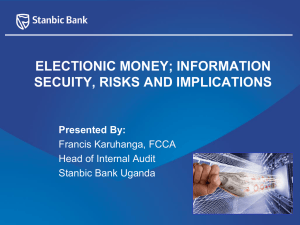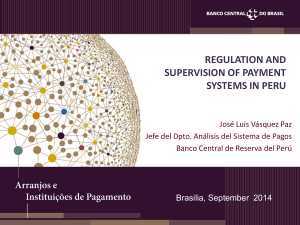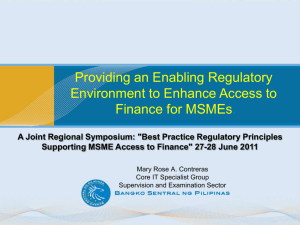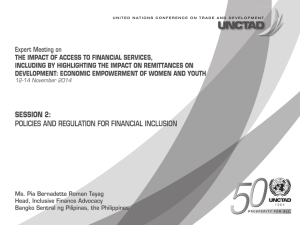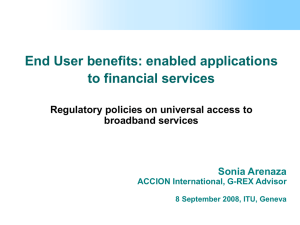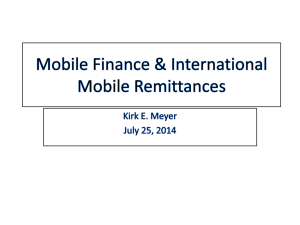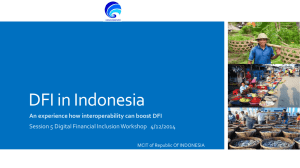Mile wide, inch deep the Uses Of e-MOney aMOng lOw
advertisement
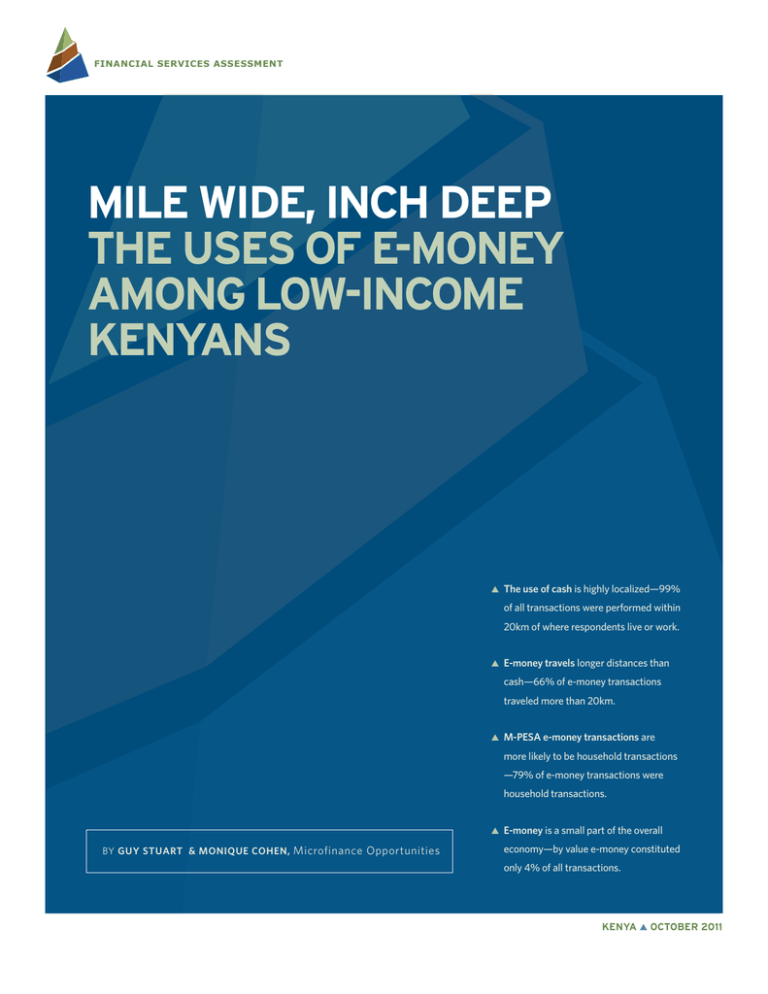
Financial Services Assessment Mile wide, inch deep The Uses of E-Money among Low-Income Kenyans s T he use of cash is highly localized—99% of all transactions were performed within 20km of where respondents live or work. s E -money travels longer distances than cash—66% of e-money transactions traveled more than 20km. s M -PESA e-money transactions are more likely to be household transactions —79% of e-money transactions were household transactions. s E -money is a small part of the overall By Guy Stuart & Monique Cohen, Microfinance Opportunities economy—by value e-money constituted only 4% of all transactions. Kenya s October 2011 E-Money use among Low-income kenyans since its 2007 launch, an estimated 13.5 million Kenyans – roughly 70 percent of the adult population—subscribe to M-PESA (“pesa” is Swahili for “money”), that country’s remarkably successful mobile phone-enabled money transfer service. A joint venture between leading telecommunications firms Vodafone and Safaricom, M-PESA’s initial marketing positioned it as a “send money home” product. One of its first advertisements showed a young man handing in money to an M-PESA agent in an urban setting, followed by a sequence showing a smiling older farmwoman, by implication the young man’s mother, receiving a text-message notification on her mobile phone of an incoming remittance. Less than five years the respective characteristics of each of the four resultant segments —local household, long-distance household, local business, and longdistance business – along a number of dimensions, including operating costs. The data suggest that for e-money to grow — to become, so to speak, a mile deep as well as a mile wide — e-money providers may find it advisable to experiment with different business models that will facilitate uptake among the business-related market segments. A new study by Microfinance Opportunities (MFO), using the Financial Diaries methodology, confirms that this early archetype remains the overwhelmingly dominant use of M-PESA. E-money in Kenya is the classic “mile wide, inch deep” phenomenon. The Kenyans in MFOs sample of 53 low-income respondents who reported using it (of 92 total respondents), did so in one specific way. This is partly due to its subscribers’ priorities and to the force of habit, but M-PESA’s current business model may also be working against its uptake in other market segments. People & Places MFO researchers were able to tease out the patterns of who sent how much money to whom, from where, for what purpose using satelliteenabled geocoding along with its own field research. MFO recruited almost 100 low-income Kenyans from both urban and provincial settings into its study, designing a diverse sample of M-PESA users versus non-users, men versus women, wage- and salary-earners versus microentrepreneurs, and married versus unmarried. The MFO research team Respondents in the MFO study reported the purpose of each e-money transaction and each cash transaction (whether it was related to business or to household) and MFO used spatial analysis to calculate the distance (local or long distance) that it travelled (long distance is defined in the study as 20 kilometers or greater). The study then analyzes FIGURE 1 - the distance/purpose framework Distance Local business Long-distance business number Amount 2,248 $320,411 68 $5,179 Purpose Cash E-money Local Household Cash number Amount Cash 44 $30,904 E-money 47 $7,048 Long-distance household number Amount 13,065 $179,318 159 $3,474 E-money Financial Services Assessment number Amount Cash 186 $11,720 E-money 362 $12,059 s2 E-Money use among Low-income kenyans recorded all weekly financial transactions, whether in the form of physical cash or e-money, for all these participants over the course of eight months between November 2009 and June 2010. In the end, this datagathering yielded more than 18,000 transactional records. MFO was able to calculate both the distance across which every remittance traveled and the distance on the ground that a person traveled to conduct a cash transaction. In every Diaries study, MFO asks the respondent for the location where each reported transaction took place. In the case of remittances, MFO also asked for the location of other party to the remittance. Then, using data from the US National GeoSpatial Agency, Google Earth, and field researchers’ local knowledge, MFO was able to geo-code (assign latitude and longitude positions to) almost all the locations reported on both the sending and the receiving side for each transaction. MFO field workers also took the latitude and longitude coordinates of the place where each respondent usually was during the day (generally the home or the workplace) using a GPS device. Consequently, for cash transactions, too, MFO was able to calculate the distance that a person physically traveled from wherever they usually were to the site of the cash exchange. Digital Travels Farther, but Cash Remains King When combined, the purpose and distance data for both cash and emoney transactions suggest that: • Cash is still “king” for both household and business transactions. - 96% of all transactions by count of transactions were in cash (94.4% by value of transactions). • The use of cash is highly localized. - 99% of all cash transactions by count were performed within 20km of where respondents live or work (92.5% by value). - 83% of all cash transactions by count were performed within 1km of where respondents live or work (71% by value). • Business transactions dominate household transactions by value. - 61% of cash transactions were for business measured in terms of the amount of money exchanged (no accurate count of business transactions is possible because respondents aggregated business sales each week). In contrast: • E-money is a small part of the overall economy. - By value e-money constituted 4% of all transactions by count (5.6% by value). • E-money travels much longer distances than does cash. - 66% of e-money transactions by count traveled more than 20km (67% by value). - 18% of e-money transactions by count were sent to someone in the same town or neighborhood or within 1km of the sender’s location (22% by value). 1 •M -PESA E-money transactions are more likely to be household trans- actions.1 - 79% of e-money transactions by count were household transactions (54% by value). - 57% of e-money transactions by count were household transactions traveling over 20km (42% by value). - 9% of e-money transactions by count were household transactions traveling within the same town or neighborhood as the sender or within 1km of their location (5% by value). Given the functionality of M-PESA, one might expect that Kenyans would more enthusiastically take it up as a substitute for cash. It is more secure than cash and it generates a record of its own usage, which might be a real advantage for someone trying to run a business or merely stick to a budget. That they have not done so—that to date, anyway, cash so resoundingly remains king—has much to do with ingrained behaviors (which are the subject of a separate Brief) and with the business model of M-PESA to which we now turn. Transactional pathways: the supply of and demand for e-money MFO examined the “transactional pathways” that respondents in its sample followed when using e-money. The pathways they followed, sequences of remittances and cash deposits and withdrawals and the size of those transactions, have implications both for the cost of supplying the M-Pesa e-money service and the price the users of the service paid. The most expensive steps in an e-money transaction occur at “cash in” and “cash out,” the points when physical cash is converted into e-money and vice versa. These steps require the presence of agents physically near the customers and within range of a mobile phone tower, both of which are fixed costs. (Safaricom already had its phone tower network largely in place when it launched M-PESA and has since built a network of more than 23,000 agents across the country.) Along with those fixed costs, the factor that makes the cash in/cash out steps the expensive part of running an e-money operation are the variable costs of managing large sums of cash, varying, that is, according to how long e-money remains “e” once it has been converted from physical cash. Compared to the costs involved in converting physical cash to e-money and back again, pushing e-money around generates very low costs. Even though M-PESA does charge customers for the service of moving e-money from one account to another, its own cost to manage an additional text message and an additional debiting and crediting of customers’ M-PESA’s accounts is very small. Here it is useful to understand what Mbiti and Weil (2010) termed the e-money loop, the number of transactions for which a given unit of emoney gets used before being converted back into physical cash. The longer the loop—the more links, so to speak, in an e-money chain—the less physical cash has to be kept on hand and the more links across which all the system’s costs can theoretically be spread. This section only includes M-PESA under e-money. The ZAP transactions are insignificant and the one Western Union transaction is distortive. Financial Services Assessment s3 E-Money use among Low-income kenyans TABLE 1 - DISTRIBUTION OF REMITTANCES BY FEE RATE FEE RATE LESS THAN 10% Relationship Share of Remittances Average Fee Rate Share of Remittances Associate 86% 3.3% 14% Family or Friend 77% 4.6% 70% Family 10% OR MORE TOTAL Nmber of Remittances Average Fee Rate 19.3% 132 5.6% 23% 16.1% 531 7.2% 4.3% 30% 18.1% 663 8.4% 67% 4.7% 33% 16.5% 263 8.6% Friend 55% 4.3% 45% 20.5% 149 11.6% Spouse 77% 4.6% 23% 16.1% 119 7.2% Grand Total Average Fee Rate Detail Total From the consumer point of view, the demand side, the length of the e-money loop and the overall pathway that a user follows has implications for the effective fee rate they pay for the service, given the M-Pesa tariff schedule, as we discuss in more detail below. A closer look, then, at how often and how quickly people cash in and out within each of the segments of MFO’s Distance/Purpose Framework will help the reader understand the cost implications for both e-money providers and their customers of serving different market segments. Household: Lots of loops, one link each Quadrant 4 of the Distance/Purpose Framework is clearly where the heat is. This is to be expected based both on M-PESA’s initial marketing strategy, which explicitly positioned the service as a “send money home” product, and on the demographic realities of Kenya. The country has a high incidence of geographically separated families, a long and deeply embedded tradition of mutual financial support and gift-giving between family members and friends, and significant growth underway in both its rural and urban populations, creating opportunities for businesses like M-PESA that connect the two. The dominant pattern in Quadrant 4 is immediate cash out. Seventyfive percent of remittances received, whose full transactional pathway MFO researchers were able to track, were converted to cash in their entirety, often on the same day they were received. They were seldom left in the account for later use, and very rarely on-sent as a remittance to someone else. In other words, in the Quadrant 4 segment that for now is the dominant locus of e-money activity, the e-money loop has a length of just one. 2 531 Business: Fewer loops, longer length The respondents receiving remittances for business purposes were more likely than the general case (40 percent vs 25 percent) to send on a business remittance received in the form of another remittance to someone else, rather than cash it out. This does not appear to be because such respondents were more likely to on-send personal remittances they had received. To the contrary, business people were as likely as the general sample (82 percent vs 75 percent) to cash out non-business-related remittances shortly after receipt. In sum, the purpose—why the e-money was sent—appears to make a difference to how long it stays in the system, and the e-money loop appears to be longer for a business transaction compared to a household one. To the extent this is true, e-money providers will incur lower marginal costs in the business segments (Quadrants 1 and 2) relative to the household ones. Face Values and Fees The remittance data suggest that M-PESA users either are willing to pay quite high fees, or are not fully aware of the fees they are paying. Table 1 shows the fee structure for M-PESA taking into account the tiered pricing policy that raises the cash-out fee from KES 252 to KES 45 at KES 2,501, from KES 45 to KES 75 at KES 5,001 and so on. It is clear from Table 1 that the smaller the amount one sends, the higher the effective fee rate. Looking only at e-money remittances, and assuming that they were all intended to be cashed out at some point, MFO calculated the total fees for each amount that respondents reported sending or receiving, and then calculated the “fee rate” (the total fees divided by the amount of cash the final recipient would pocket The conversion rate used in the MFO report on which this Brief is based was KES 47 to PPP 1. Financial Services Assessment s4 E-Money use among Low-income kenyans upon cash out). In the sample, 30 percent of the remittances were in amounts that resulted in a final fee rate of 10 percent or more. And 58 percent were in amounts that resulted in a fee rate of 5 percent or more. The average fee rate of remittances ends up varying by the nature of the relationship between sender and recipient. A respondent was more likely to send/receive a remittance with a lower fee rate (and hence larger amount) to/from someone who is not a friend or relative (i.e., someone with whom one was doing business as opposed to engaging in gift-giving). The average fee rate for such remittances was 5.6 percent. In contrast, remittances to friends or family were likely to be smaller and thus incurred a higher fee rate: 9 percent. Two factors are likely driving this phenomenon. First, the business transactions tended to be larger, thus incurring lower fee rates. Second, it is likely that people are prepared to pay the higher effective fees associated with sending the smaller, family- and friend-focused remittances because in those instances, it is not just about getting the money from point A to point B. It is also a “touch,” a way of strengthening bonds of affection, reciprocity, or obligation. Interestingly, remittance amounts did not increase, and hence fee rates decrease, the further the distance the remittance traveled, in fact respondents sent or received many small, local remittances. In sum, the data suggest that people are willing to pay fairly high fee rates to use M-PESA in the specific segment where it adds significant value (i.e., speed and safety) to something that was already important to them to do (send money to friends and loved ones living elsewhere). That said, they could lower the fees they pay within the current tariff structure in a number of ways. Lowering the Costs . . . One would be to “send money home” in fewer but bigger amounts. A husband who sends his wife back on the farm a monthly remittance of KES 2,000, for example, instead of four weekly payments of KES 500 each over the course of that same month would reduce her cash-out fees by 75 percent—but only if she was able to take possession of the full amount all at once (and thereby only incur one cash-out charge instead of four). Numerous factors might make that idea impractical, ranging from how much and how quickly the husband earns his money to how much and when the wife needs money to run the farm, not to mention their respective degrees of financial discipline. Another fee-reduction strategy would be to lengthen the e-money loop, and thus avoid cash-out fees, but only in amounts greater than or equal to KES 2,500. M-PESA’s current tariff structure makes it more expensive to on-send a remittance than to cash it out for amounts less than that— the flat fee for on-sending remittances of any size is KES 30, while the cash-out fee for amounts up to KES 2,500 is KES 25, rising to KES 45 for amounts between KES 2,501 and KES 5,000. So how often did individuals in the MFO sample spend KES 2,500 on any single good or service? The short answer is: Not very. MFO’s survey instrument is structured to have respondents report their cash transactions for each week. In cases where they bought the same good or service at many different times during the week MFO asked them to Financial Services Assessment aggregate the amount spent on that particular good or service for the whole week (so as not to overwhelm the data-gathering system). Thus, for example, the system captures weekly “groceries” rather than every single egg or tomato day after day. Nevertheless, almost half of all the transactions (both single and aggregated) reported in the MFO study involved an amount under KES 200 —less than one-tenth the magic number at which on-sending e-money begins to make economic sense under M-PESA’s current tariff structure. Most of these were household transactions. So despite the fact that the M-PESA users have shown themselves to be willing to pay high fees to use the service in the all-important Quadrant 4, the economics of Quadrant 3 household transactions militate against its uptake as a cash substitute in that domain. In fact, only six percent of all transactions reported in the study were at or above the KES 2,500 magic number. But among that small universe of transactions, a higher proportion came from the business segments. As a result, under the current tariff structure, it makes sense for business people to extend the e-money loop through their business expenditures, because those expenditures are more often of a sufficient size to make it more cost effective to on-send money for business purchases than to cash out and then use the cash for those purchases. The challenge to growing the big-ticket business transaction market, at least in the Quadrant 2 long-distance subsegment, boils down to trust. Low-income Kenyans, like low-income people in other countries, tend to have little trust in financial services providers. It is very important to them to receive written receipts of financial transactions (Cohen et al 2008). One likely reason why M-PESA, which only generates “digital receipts,” took off as it did among the family and friends market first is that people in that segment could verify the transactions themselves, by telephoning each other to confirm that the money went through. That equation changes in the business segments, where most transactions are conducted between people who do not have such a social bond . . . Or Changing the Costs As noted above, the very small amounts involved in local household transactions mean that customers and merchants would have to be willing to pay fairly large transaction fees if they were to use M-PESA for regular retail purchases—household transactions in our terminology. Most of the time, it is probably not worth it under M-PESA’s current tariff structure. But the Kenya experience provides one specific example of a local-business context where, for the strong motivation of personal security, it is worth it to use M-PESA even for small amounts. The case of the Kenyan taxi drivers provides an intriguing glimpse into the possibilities of growing the business-related market segments for e-money. Taxi drivers sometimes accept M-PESA as payment for fares because they often operate in neighborhoods where carrying a lot of cash is a bad idea. Even though the taxi driver and his passenger are not friends or relatives, the trust factor is not the issue it would be for remote business transactions between strangers across long distance. The taxi driver and his passenger are literally face to face. s5 E-Money use among Low-income kenyans The e-money provider could offer the taxi driver a significant discount on transaction fees if he meets a minimum number of transactions per day, week, or some other period, say a drop in the fee from $0.63 per transaction to $0.06 per transaction for 10 or more transactions per day. With such a discount, the driver would have an extra incentive to accept fares in the form of e-money and absorb the discounted fee. When it came time to buy gasoline, the taxi driver could pay for it with e-money. The e-money provider might encourage the filling station to accept the payment by providing them with a discount for accepting e-money payments for even small amounts of gas purchases. And the filling station and the taxi driver might both get an additional discount for being in each other’s preferred associates network, as a way to get businesses to encourage each other to use e-money for payments. The Sweet Spot Given its dramatic success, it is easy to forget that M-PESA has been in operation for less than five years. It stands to reason both that M-PESA would have started out by picking the low-hanging fruit—the “send money home” business in Quadrant 4—and that a trial-and-error period will likely be needed before the service scales up in the other quadrants. The specifics of the ideas illustrated by the example above of the taxi driver and the filling station may or may not be practical or desirable. But the broader point is that e-money has a genuine market opportunity to serve the business community provided that the issues related to trust (in the long-distance subsegment) and to cost structure can be resolved. The transactional data from the MFO study bear this out. The median e-money business transaction was much larger than the median emoney household transaction, resulting in a lower fee rate for the former than the latter. At the same time, if business users have a longer e-money loop—as they appear to do—then the cost of serving them is likely to be lower. In essence, business transactions represent a “sweet spot” where the relative price of the service is lower and the marginal cost of supplying it is lower, too. This brief is based on Cash In, Cash Out Kenya: The Role of M-PESA in the Lives of Low-Income People (September 2011) by Guy Stuart and Monique Cohen. The original report can be downloaded in PDF form from www.microfinanceopportunities.org. The report is part of the Financial Services Assessment project, information about which can be found on the web at http://www.fsassessment.umd.edu/ Financial Services Assessment s6 ABOUT THE AUTHORs This study is part of the Financial Services Assessment project, undertaken by the IRIS Center at the University of Maryland and its partner, Microfinance Opportunities. The goal is to assess the impact of grants provided by the Bill and Melinda Gates Foundation to microfinance organizations for the development of innovations in financial services. www.fsassessment.umd.edu Dr. Guy Stuart is a Lecturer in Public Policy at the Kennedy School of Government, Harvard University. He uses “bottom up” methods, such as Financial Diaries and Participatory Research, to help microfinance organizations find the best ways to serve their clients. He holds a Ph.D. in political science from the University of Chicago. Dr. Monique Cohen, Founder and President of Microfinance Opportunities, is a leading international authority on the use of financial services by the poor. She currently supervises a team which employs the innovative Financial Diaries methodology to assess financial behaviors and preferences in Kenya and Malawi. Dr. Cohen spearheaded the groundbreaking “Global Financial Education Program” which builds the financial capabilities of the poor using a range of media tools and workshops. Together with MicroSave she developed “Listening to Clients,” a visual and interactive market research microfinance training toolkit. Dr. Cohen is on multiple advisory committees, speaks regularly at microfinance conferences around the world, and is widely published. Prior to founding Microfinance Opportunities, she led the “Assessing the Impact of Microenterprise Services” (AIMS) project at USAID. FUNDING Financial Services Assessment is funded by a $6 million grant from the Bill & Melinda Gates Foundation. REPORT SERIES This report is part of a series that will be generated by the Financial Services Assessment project. The reports are disseminated to a broad audience including microfinance institutions and practitioners, donors, commercial and private-sector partners, policymakers, and researchers. ADDITIONAL COPIES You may download additional copies at www.fsassessment.umd.edu. CONTACT IRIS IRIS Center University of Maryland Department of Economics 3106 Morrill Hall College Park, MD 20742 (USA) E-mail: Phone: Fax: Web: info@iris.umd.edu +1.301.405.3110 +1.301.405.3020 www.iris.umd.edu CONTACT MICROFINANCE OPPORTUNITIES 1701 K Street, NW Suite 650 Washington, DC 20006 (USA) E-mail: Phone: Fax: Web: info@mfopps.org +1.202.721.0050 +1.202.721.0010 www.microfinanceopportunities.org
